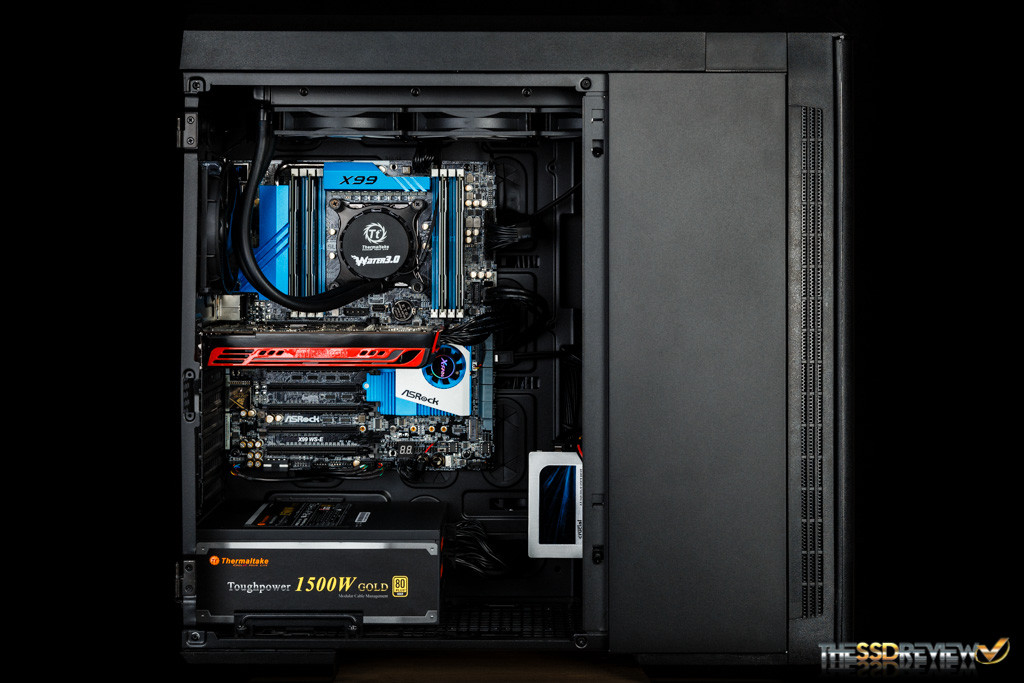TEST SETUP AND METHODOLOGY
In testing the SanDisk CloudSpeed Eco, along with all enterprise drives, we focus on long term stability. In doing so, we stress products not only to their maximum rates, but also with workloads suited to enterprise environments.
We use many off-the-shelf tests to determine performance, but we also have specialized tests to explore specific behaviors we encounter. With enterprise drives, you will see that we do not focus on many consumer level use-cases.
Our hope is that we present tangible results that provide relevant information to the buying public.
SYSTEM COMPONENTS
| PC CHASSIS: | Thermaltake Urban T81 |
| MOTHERBOARD: | ASRock X99 WS-E |
| CPU: | Intel Xeon E5-2690 v3 |
| CPU COOLER: | Thermaltake Water 3.0 Ultimate |
| POWER SUPPLY: | Thermaltake Toughpower 1500W Gold |
| GRAPHICS: | XFX 5770 |
| SYSTEM COOLING: | be quiet! Silent Wings 2 |
| MEMORY: | Crucial Ballistix Sport DDR4 2400MHz |
| STORAGE: | Crucial MX200 500GB |
| IRST: | 13.1.0.1058 |
This Test Bench build was the result of some great relationships and purchase; our appreciation goes to those who jumped in specifically to help the cause. Key contributors to this build are our friends at ASRock for the motherboard and CPU, be quiet! for the cooling fans, and Thermaltake for the case. We have detailed all components in the table below and they are all linked should you wish to make a duplicate of our system as so many seem to do, or check out the price of any single component. As always, we appreciate your support in any purchase through our links!
LATENCY
To specifically measure latency, we use a series of 512b, 4K, and 8K measurements. At each block size, latency is measured for 100% read, 65% read/35% write, and 100% write/0% read mixes.
The CloudSpeed Eco shows some good initial latency results when it comes to read latency. During write and mixed-write workloads, however, the average latency averages a bit higher than the <2.0ms rating maintaining up to 3.5ms for 0.5KB writes and up to 3ms for 8KB writes. All values for the 4KB file size, however, stay within spec.
Maximum latency calculations help show us if an SSD has inconsistent behavior that cannot be observed when viewing the averaged data. Over the course of our testing the maximum latency recorded was under 30ms, which is decent. Overall, the values recorded are better than the Micron M500DC we reviewed last year.
ADVANCED WRITE TESTING
As we talked about in our Micron P400m SSD Review, SSDs have different performance states. Since this drive is an enterprise SSD, we will focus on steady state performance. With the following tests, we stressed the drive using random 4KB write workloads across the entire span for at least 24 hours. This is more than enough to achieve steady state. The following graph is showing the 1 minute averages of latency and IOPS across an 11 hour span.
Looking at 1 minute averages, the SanDisk CloudSpeed Eco showed performance a bit lower than we were expecting. Here we see an average latency of around 2.6ms, which again illustrates slightly longer latency than the rated <2.0ms spec. Write IOPS averaged about 12.5K rather than the rated 14K.
Now we are zooming into the last hour of our testing and looking at 1 second averages. With this closer look, we see while the average is about 2.6ms and the average IOPS is 12.5K, there is a bit of deviation. Latency ranges mainly from about 1.8ms to 3.6ms with a few outliers reaching up to 5.6ms and we can see the majority of IOPS ranging from about 10K to almost 15K. While this type of performance isn’t too bad when looking at the product and its position in the market, it isn’t the best out there. When looking back at our review of the Samsung 845DC EVO with a similar write rating we see a much tighter distribution and thus, more consistent and predicable performance over the CloudSpeed Eco.
 The SSD Review The Worlds Dedicated SSD Education and Review Resource |
The SSD Review The Worlds Dedicated SSD Education and Review Resource | 

